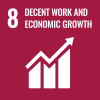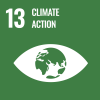
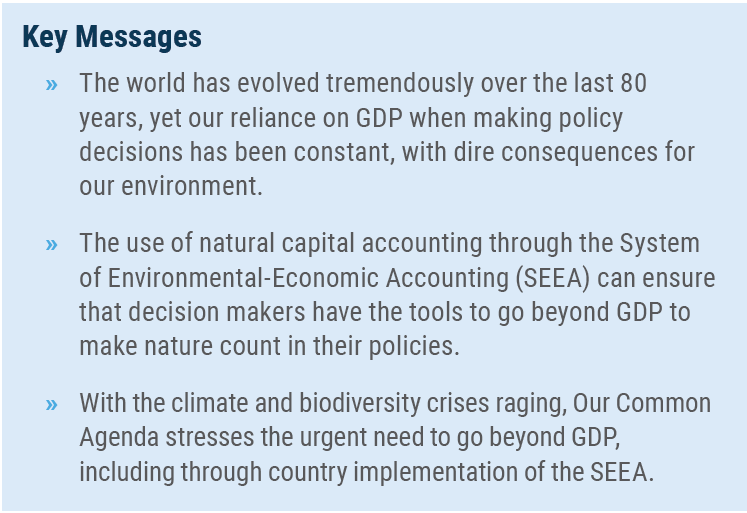 The world has changed enormously over the past 80 years—we are richer and more interconnected than ever before, yet we also face unprecedented challenges, notably the climate and biodiversity crises. The Earth is hotter than it has ever been, with the warmest seven years occurring since 2015. The state of biodiversity is doing no better, with roughly a quarter of species assessed facing a high risk of extinction in the near future. Despite the brave new world that humanity now faces, one thing has remained steadfast over these past 80 years—our use of gross domestic product (GDP) in decision making. Gross domestic product is perhaps the most well-known and used statistic in the world. Virtually all countries compile GDP, which is derived from the System of National Accounts (SNA). However, over time GDP has been wrongly interpreted as a proxy for overall wellbeing and welfare rather than what it is—that is, a summary figure for economic activity. Unfortunately, this misuse of GDP has been at great peril, particularly to the environment. One of the most common criticisms of GDP is that it completely ignores the depletion and degradation of the environment. In fact, GDP actually can treat depletion and degradation of the environment as economic output. In an extreme example, cutting down large swaths of rainforests for timber without a plan for reforestation would increase GDP in the short term despite having a devastating effect on the climate and long-term economic growth and wellbeing. For reasons such as these, the need to go “beyond GDP” has been on the policy agenda ever since the seminal 2008 Stiglitz-Sen-Fitoussi report, commissioned by the government of France. While policy makers have been slow to react, they are now beginning to take heed of the calls to go beyond GDP—quite possibly because we no longer have the luxury of time. The UN Common Agenda, the Secretary-General’s blueprint for the next 25 years, urges a paradigm shift in how we measure and think about progress:
The world has changed enormously over the past 80 years—we are richer and more interconnected than ever before, yet we also face unprecedented challenges, notably the climate and biodiversity crises. The Earth is hotter than it has ever been, with the warmest seven years occurring since 2015. The state of biodiversity is doing no better, with roughly a quarter of species assessed facing a high risk of extinction in the near future. Despite the brave new world that humanity now faces, one thing has remained steadfast over these past 80 years—our use of gross domestic product (GDP) in decision making. Gross domestic product is perhaps the most well-known and used statistic in the world. Virtually all countries compile GDP, which is derived from the System of National Accounts (SNA). However, over time GDP has been wrongly interpreted as a proxy for overall wellbeing and welfare rather than what it is—that is, a summary figure for economic activity. Unfortunately, this misuse of GDP has been at great peril, particularly to the environment. One of the most common criticisms of GDP is that it completely ignores the depletion and degradation of the environment. In fact, GDP actually can treat depletion and degradation of the environment as economic output. In an extreme example, cutting down large swaths of rainforests for timber without a plan for reforestation would increase GDP in the short term despite having a devastating effect on the climate and long-term economic growth and wellbeing. For reasons such as these, the need to go “beyond GDP” has been on the policy agenda ever since the seminal 2008 Stiglitz-Sen-Fitoussi report, commissioned by the government of France. While policy makers have been slow to react, they are now beginning to take heed of the calls to go beyond GDP—quite possibly because we no longer have the luxury of time. The UN Common Agenda, the Secretary-General’s blueprint for the next 25 years, urges a paradigm shift in how we measure and think about progress:
“Now is the time to correct a glaring blind spot in how we measure economic prosperity and progress. When profits come at the expense of people and our planet, we are left with an incomplete picture of the true cost of economic growth.”
Natural capital accounting
But how exactly can policy makers correct this blind spot and go “beyond GDP”? As stated in the Stiglitz-Sen-Fitoussi report, policy makers should not rely on a single indicator—they need a dashboard of indicators that can reveal the factors contributing to the economy’s success and whether growth is environmentally sustainable. Moreover, to be truly effective and avoid comparing apples with oranges, this dashboard must be derived from rigorous, consistent data, and the indicators in this dashboard should be complementary to each other, as well as GDP. Therein lies the value of natural capital accounting (NCA). Natural capital accounting comprises the use of an accounting framework, not dissimilar to financial accounting frameworks, to provide a systematic way to measure and report on stocks and flows of natural capital. Its underlying premise is that nature should be recognized as an asset that must be maintained and managed, and its contributions to the economy (e.g. natural resources and ecosystem services) should be integrated into commonly used frameworks such as the SNA. In short, NCA puts nature on the balance sheet, making it visible in the data that feeds into policy and decision making. It is for this reason, that the UN Common Agenda urges Member States to begin implementation of the System of Environmental-Economic Accounting (SEEA), the international statistical standard for natural capital accounting.
A statistical standard to make nature count
The SEEA is composed of two parts—the SEEA Central Framework, adopted in 2012 as an international statistical standard by the UN Statistical Commission—and the SEEA Ecosystem Accounting, adopted just last year. The SEEA’s use of an accounting structure and many of the concepts and definitions of the SNA allows it to link environmental data with economic data in a coherent way. The SEEA Central Framework was developed first and measures individual natural resources (e.g. water, timber, energy, etc), how they are extracted and used within the economy, and how they flow back to the environment through residuals such as air emissions or waste. Importantly, the SEEA Central Framework includes information in both physical and monetary terms. Not only does it provide a way to measure the amount of timber harvested, but also (by combining physical and monetary information) the cost of depletion. As a result, it is possible to subtract the costs of natural resource depletion from GDP, thereby creating an environmentally-adjusted GDP, or “green GDP”. However, even though green GDP is a multi-faceted indicator, relying upon a single indicator usually does not serve the purposes of going beyond GDP. Thankfully, the SEEA Central Framework can provide input to a coherent dashboard of indicators, as recommended by the 2008 Stiglitz-Sen-Fitoussi report. Countries can use the SEEA to understand their energy or water efficiencies by economic sector, their material footprints and the greenhouse gas intensities of the economy. For example, SEEA accounts have been used to track the development of resource productivity in comparison with GDP and domestic material consumption. Comparing resource use with GDP is possible because the scope, definitions and classifications of the SEEA are consistent with the SNA. As shown below, the EU has demonstrated that economic growth can accompany increases in resource productivity and decreases in domestic material consumption (see Figure 1). 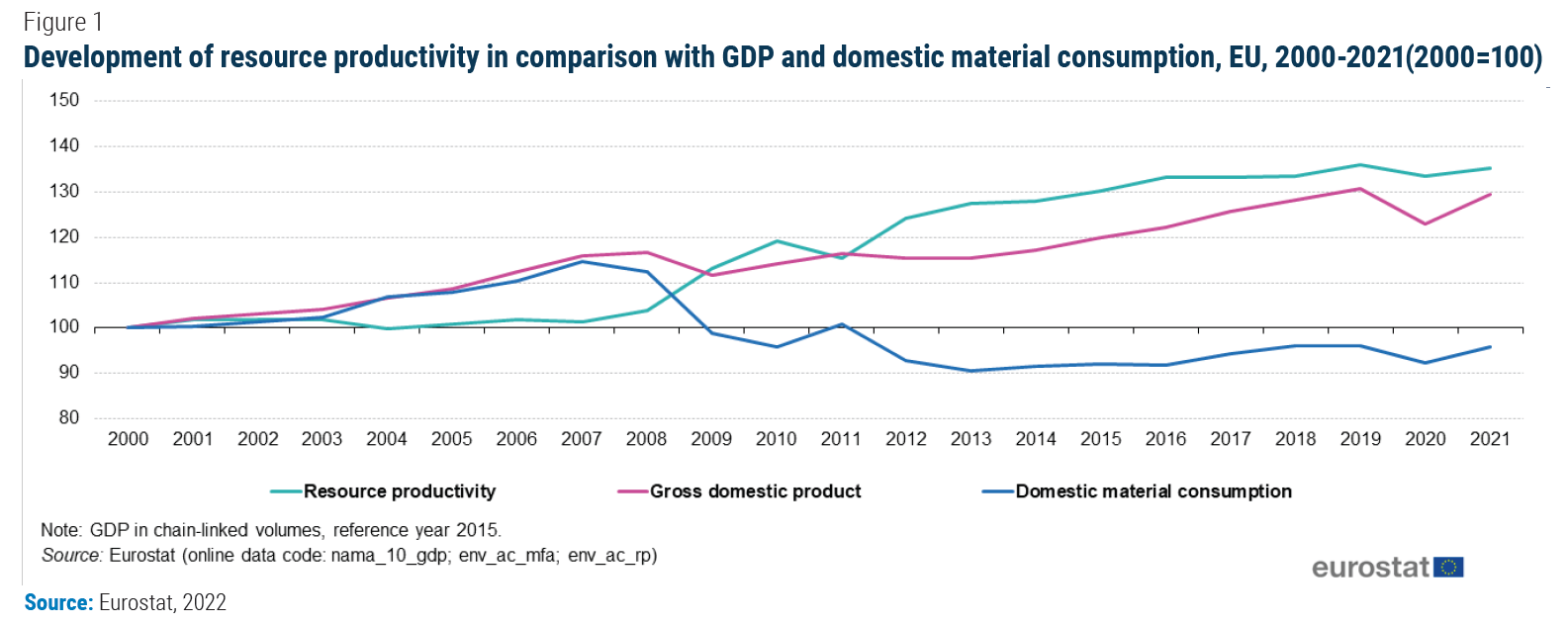 In addition, policy makers are beginning to realize the overall importance of looking at stock measures in addition to flow-type indicators such as (green) GDP. The culmination of this thinking is evident in the recent Dasgupta Review on the Economics of Biodiversity, commissioned by the U.K. Treasury in 2021. The main premise of the Review is that looking at flow indicators alone (such as GDP) can be misleading. This is because sustainability depends on stocks—namely our stocks of natural assets—our forests, trees, etc—and their ability to regenerate. It is well recognized that produced and human capital are assets which future generations depend upon, and the Review argues that we can and must do the same for nature and biodiversity. The recently adopted SEEA Ecosystem Accounting takes this approach to heart. Adopted by the UN Statistical Commission in 2021, the SEEA Ecosystem Accounting portrays ecosystems as assets which provide humanity with vital ecosystem services, from air filtration to carbon storage to recreation-related services. These ecosystem assets must be maintained, so the SEEA Ecosystem Accounting measures the size and quantity of these assets through extent accounts and the health of these assets through condition accounts. The framework also includes ecosystem service flow accounts. Similar to the SEEA Central Framework, these service accounts can be in both physical and monetary terms, with the monetary ecosystem accounts using valuation principles consistent with the SNA. Finally, monetary ecosystem asset accounts record the value of opening and closing stocks of ecosystem assets. These values are determined by valuing the expected future flows of ecosystem services over time. Thus, similar to how we have long evaluated investments in produced capital by looking at higher expected income over time (i.e. higher returns), we can now do the same for nature and ecosystems.
In addition, policy makers are beginning to realize the overall importance of looking at stock measures in addition to flow-type indicators such as (green) GDP. The culmination of this thinking is evident in the recent Dasgupta Review on the Economics of Biodiversity, commissioned by the U.K. Treasury in 2021. The main premise of the Review is that looking at flow indicators alone (such as GDP) can be misleading. This is because sustainability depends on stocks—namely our stocks of natural assets—our forests, trees, etc—and their ability to regenerate. It is well recognized that produced and human capital are assets which future generations depend upon, and the Review argues that we can and must do the same for nature and biodiversity. The recently adopted SEEA Ecosystem Accounting takes this approach to heart. Adopted by the UN Statistical Commission in 2021, the SEEA Ecosystem Accounting portrays ecosystems as assets which provide humanity with vital ecosystem services, from air filtration to carbon storage to recreation-related services. These ecosystem assets must be maintained, so the SEEA Ecosystem Accounting measures the size and quantity of these assets through extent accounts and the health of these assets through condition accounts. The framework also includes ecosystem service flow accounts. Similar to the SEEA Central Framework, these service accounts can be in both physical and monetary terms, with the monetary ecosystem accounts using valuation principles consistent with the SNA. Finally, monetary ecosystem asset accounts record the value of opening and closing stocks of ecosystem assets. These values are determined by valuing the expected future flows of ecosystem services over time. Thus, similar to how we have long evaluated investments in produced capital by looking at higher expected income over time (i.e. higher returns), we can now do the same for nature and ecosystems. 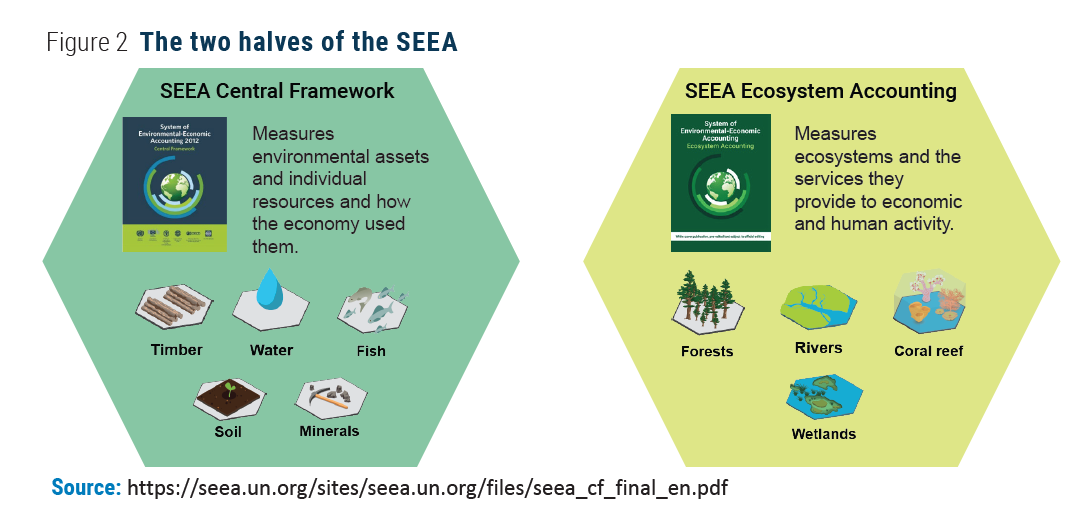 Countries have already begun to implement ecosystem accounts. For instance, under the EU funded Natural Capital Accounting and Valuation of Ecosystem Services Project, India compiled ecosystem extent, condition, services and a monetary asset account for the state of Karnataka. The monetary asset account for Karnataka showed that there has been a considerable decline in ecosystem services, particularly in forest ecosystems, between 2015 and 2019. Forest ecosystems saw a 51.6% reduction in provisioning services and a 27.1% reduction in regulating services. This was reflected in ecosystem asset accounts, which indicated that forest ecosystem asset values decreased significantly, with a 35.4% decrease, which could be attributed to the degradation of forest ecosystems and their conversion to agricultural ecosystems (see Table 1). The pilot in Karnataka concludes that forest resources have undergone tremendous change and degradation because their value is oftentimes poorly understood and therefore not sufficiently considered in policy decisions. However, the pilot has also resulted in various policy recommendations on how the accounts can inform afforestation policies and help achieve targets formulated under (sub)national forest policies such as the 10-year Green India Mission.
Countries have already begun to implement ecosystem accounts. For instance, under the EU funded Natural Capital Accounting and Valuation of Ecosystem Services Project, India compiled ecosystem extent, condition, services and a monetary asset account for the state of Karnataka. The monetary asset account for Karnataka showed that there has been a considerable decline in ecosystem services, particularly in forest ecosystems, between 2015 and 2019. Forest ecosystems saw a 51.6% reduction in provisioning services and a 27.1% reduction in regulating services. This was reflected in ecosystem asset accounts, which indicated that forest ecosystem asset values decreased significantly, with a 35.4% decrease, which could be attributed to the degradation of forest ecosystems and their conversion to agricultural ecosystems (see Table 1). The pilot in Karnataka concludes that forest resources have undergone tremendous change and degradation because their value is oftentimes poorly understood and therefore not sufficiently considered in policy decisions. However, the pilot has also resulted in various policy recommendations on how the accounts can inform afforestation policies and help achieve targets formulated under (sub)national forest policies such as the 10-year Green India Mission.
Growing implementation
Currently 90 countries around the world, both developing and developed, compile the SEEA. The SEEA has been compiled for decades in some of these countries, for example in the E.U., the Philippines, Mexico, and many others. Most recently, the United States has announced their intention to develop SEEA accounts through their National Strategy to Develop Statistics for Environmental-Economic Decisions. The private sector is also beginning taking note of the SEEA; as standards organizations develop environmental sustainability disclosure recommendations, there is the desire to draw upon existing standards and knowledge such as the SEEA. 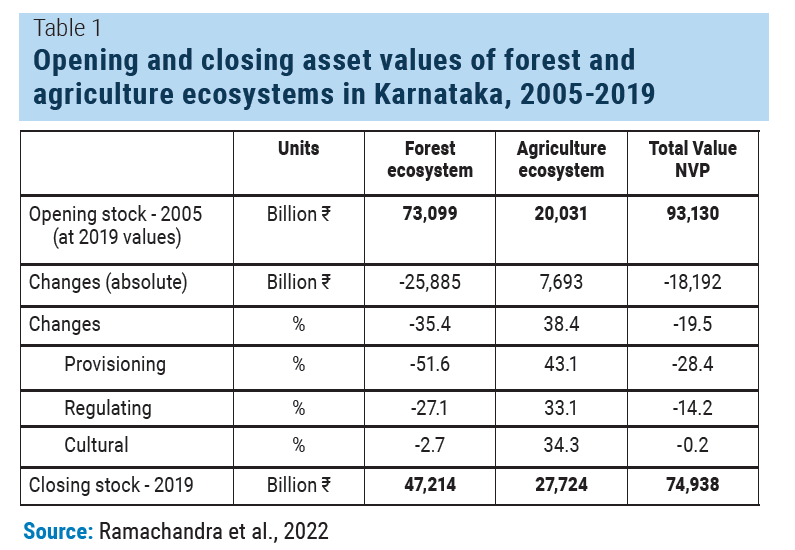 Implementation of the accounts is expected to accelerate given the recent adoption of the SEEA Ecosystem Accounting, and demand for systematic information on nature and its relationship with economic and human activities. According to an analysis by the UN Committee of Experts on Environmental-Economic Accounting, the SEEA can inform 40 Sustainable Development Goal (SDG) indicators over 9 different goals. In addition, the SEEA is expected to play an important role in the post-2020 global biodiversity framework. As Parties to the Convention on Biological Diversity (CBD) gather in Montreal in December this year, they are expected to adopt a monitoring framework to track progress towards biodiversity goals. The SEEA is currently used for multiple goals and targets of the monitoring framework and will play an important role in ensuring that rigorous official statistics will contribute to monitoring biodiversity goals. The SEEA is also playing an important role in monitoring the drivers, impacts and policy responses of climate change. Given the SEEA’s focus on the link between the environment and economy, SEEA air emission, carbon accounts and environmental activity accounts (e.g. taxes, subsidies, etc) provide an important complement to the existing Intergovernmental Panel on Climate Change (IPCC) framework and greenhouse gas emission inventories. For instance, IPCC inventories can provide rigorous scientific data on greenhouse gases, and the SEEA can link this information to the economy to help understand the climate footprint of different economic activities. In addition, the recent UN Ocean Conference this summer in Lisbon stressed the importance of the ocean and ocean economy to the world. The statistical, scientific and geospatial communities are hard at work in developing a SEEA Ocean that ensures that policy makers can make oceans count in their balance sheets.
Implementation of the accounts is expected to accelerate given the recent adoption of the SEEA Ecosystem Accounting, and demand for systematic information on nature and its relationship with economic and human activities. According to an analysis by the UN Committee of Experts on Environmental-Economic Accounting, the SEEA can inform 40 Sustainable Development Goal (SDG) indicators over 9 different goals. In addition, the SEEA is expected to play an important role in the post-2020 global biodiversity framework. As Parties to the Convention on Biological Diversity (CBD) gather in Montreal in December this year, they are expected to adopt a monitoring framework to track progress towards biodiversity goals. The SEEA is currently used for multiple goals and targets of the monitoring framework and will play an important role in ensuring that rigorous official statistics will contribute to monitoring biodiversity goals. The SEEA is also playing an important role in monitoring the drivers, impacts and policy responses of climate change. Given the SEEA’s focus on the link between the environment and economy, SEEA air emission, carbon accounts and environmental activity accounts (e.g. taxes, subsidies, etc) provide an important complement to the existing Intergovernmental Panel on Climate Change (IPCC) framework and greenhouse gas emission inventories. For instance, IPCC inventories can provide rigorous scientific data on greenhouse gases, and the SEEA can link this information to the economy to help understand the climate footprint of different economic activities. In addition, the recent UN Ocean Conference this summer in Lisbon stressed the importance of the ocean and ocean economy to the world. The statistical, scientific and geospatial communities are hard at work in developing a SEEA Ocean that ensures that policy makers can make oceans count in their balance sheets.
Time to move forward
It has been more than a decade since the release of the 2008 Stiglitz-Sen-Fitoussi report, and it is imperative that the international community accelerates the push to go beyond GDP. The climate and biodiversity crises show no signs of slowing—in fact, the speed at which the climate has warmed, natural disasters have hit, and species have disappeared has been faster than ever before. With Governments still directing more than US$5 trillion in annual subsidies to fossil fuels, non-sustainable agriculture and fishing, non-renewable energy, mining and transportation, it is clear a paradigm shift is needed in the data that is used for policy making. As stated by UN Secretary-General Antonio Guterres upon the adoption of the SEEA Ecosystem Accounting last year, “This is a historic step towards transforming how we view and value nature. We will no longer be heedlessly allowing environmental destruction and degradation to be considered economic progress.”
 Welcome to the United Nations
Welcome to the United Nations
